罗马 ROME
- 格式:pps
- 大小:5.16 MB
- 文档页数:37
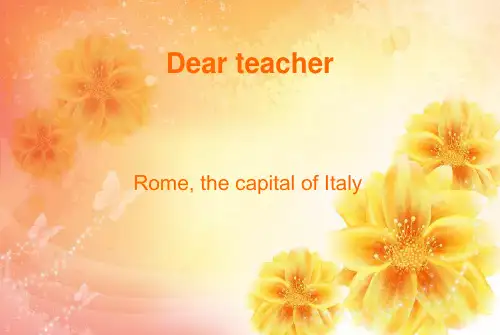
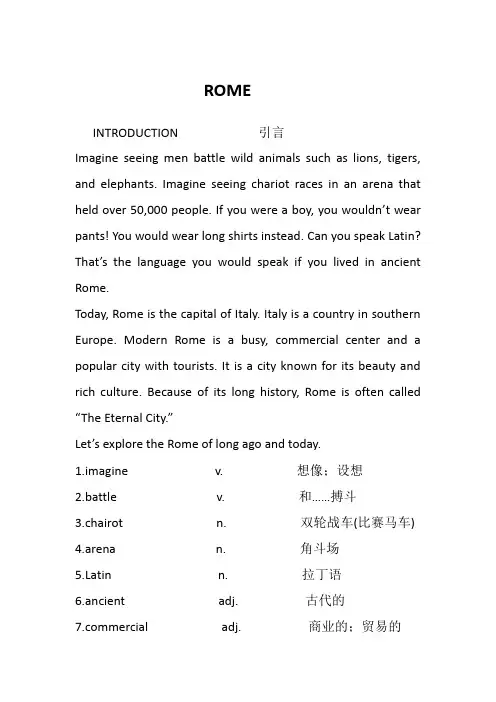
ROMEINTRODUCTION 引言Imagine seeing men battle wild animals such as lions, tigers, and elephants. Imagine seeing chariot races in an arena that held over 50,000 people. If you were a boy, you wouldn’t wear pants! You would wear long shirts instead. Can you speak Latin? That’s the language you would speak if you lived in ancient Rome.Today, Rome is the capital of Italy. Italy is a country in southern Europe. Modern Rome is a busy, commercial center and a popular city with tourists. It is a city known for its beauty and rich culture. Because of its long history, Rome is often called “The Eternal City.”Let’s explore the Rome of long ago and today.1.imagine v. 想像;设想2.battle v. 和……搏斗3.chairot n. 双轮战车(比赛马车)4.arena n. 角斗场tin n. 拉丁语6.ancient adj. 古代的mercial adj. 商业的;贸易的8.culture n. 文化9.the Eternal City 不朽城(罗马的别称)10.explore v. 探索;探究ROME:THEN AND NOW罗马:历史与今天Rome was the center of a great civilization long ago. Laws and government were very important to its people. Ancient Romans were also great builders, especially of roads and waterways Many of their ideas about government and building are still important to us today.Long ago, the Romans united different lands into an empire. The Roman Empire covered most of Europe. Rome was the most important city in the empire. More than a million people lived there. An emperor ruled this vest empire. Under one ruler, many of the people in the empire led comfortable lives. There were few wars. It was a time of peace.Look at the two maps. How is the Roman Empire different from and the same as modern Italy? Can you tell which modern countries used to be part of the Roman Empire? Along what body of water are most of these countries located?Today, the Roman Empire no longer exists. Rome, once the center of this great empire, is still an important city. It is the largest city in Italy. More than three million people live in the city of Rome and its surrounding suburbs.1.locate v. 坐落于;位于2.exist v. 存在3.surrounding adj. 周围的4.suburb n 市郊;郊区5.base on 基于6.Romance languages 罗曼(诸)语7.Portuguese n. 葡萄牙语8.Pantheon 万神庙9.temple n. 庙宇;寺院10.honor v. 尊敬;纪念FOODIn ancient Rome, what did the people eat? For breakfast, poor people usually had bread and water. The main meal each day was dinner. It began in the late afternoon so it could end by sunset. And porridge, which is like oatmeal.Rich Romans ate many different foods. How do we know? Someancient recipes have survived. Cooks used herbs and spices.Spices helped to hide the fact that many foods were not fresh. People could not refrigerate food.Today, some people living in small towns still take a long lunch. Shops usually close from 1:00 to 4:00 and then reopen until 8:00. Children come from school and parents from work to eat together. Lunch has many courses, such as a salad , rice or pasta, a main course, then dessert. However, in Rome and other big cities, most people take only an hour or so for lunch. Some shops close during lunchtime.1.porridge n. 粥2.oatmeal n. 燕麦片粥3.recipe n. 食谱4.survive v. 幸存;留存5.herb n. 药草;香草6.spice n. 香料;调料7.refrigerate v. 冷冻;冷藏8.course n. 一道菜9.pasta n. 意大利面食(包括通心粉及细面条等)10.d essert n. 甜(尾)食;甜点心11.b anquet n. 宴会12.f east n. 盛宴;筵席13.t una fish 金枪鱼肉14.o strich meat 鸵鸟肉SCHOOLIn ancient Rome,there were no public schools. Some families sent their children to small local schools. These families had to pay a fee. Very few girls went to school. School began to sunrise and ended in the early afternoon. Children had the summers off. Some wealthy families hired tutors to teach their sons at home. The tutors were often Greek slaves. Fathers taught their sons outdoor skills, such as horseback-riding, swimming, and fighting with weapons.Children began school when they were six or seven. They learned reading, writing, and arithmetic. After age 11, students studied famous Greek and Roman writers and poets. They also studies music and astronomy. Most students left school at age 16. If they wanted to be lawyers or politicians, they hired special tutors to continue their studies.Today, public schools in Italy are free. Children must go to school from ages 6 to 14. Children between the ages of 11 and 14 go to middle school. When they finish middle school, students choose the kind of high school they will go to. They might choose a high school that teaches about computers or science. After high school, some students attend a university.1.local adj. 当地的2.fee n. 费3.wealthy adj. 富有的4.hire v. 雇请;雇用5.tutor n. 家庭教师6.slave n. 奴隶7.weapon n. 武器8.arithmetic n. 算术9.poet n. 诗人10.astronomy n. 天文学wyer n. 律师12.politician n. 政治家13.university n. 大学ROMAN SYSTEMS罗马的城市设施与道路交通WATERIn ancient Rome, many people believed that polluted, or dirty water caused disease. To keep people healthy, the Romans built a system of aqueducts. Aqueducts brought millions of liters (gallons) of water from neighboring hills into the city every day.The water was used for drinking and for the baths and fountains. Lead pipes connected to the aqueducts supplied water to the houses in the city. The city also had underground sewers to carry away sewage.In the countryside, aqueducts brought water to places where it was needed. Farmers used the water to irrigate their crops. Some of the ruins of these ancient water systems still stand today.Today, Rome has modern plumbing. Its water-supply system is much like the aqueducts of long ago. Pipes still supply the city with water.1.pollute v. 污染2.disease n. 疾病3.aqueduct n. 沟渠;高架渠4.liter n. 公升5.gallon n. 加仑(英制液体单位)6.lead pipe 铅管7.connect to 连接8.supply v. 供给;提供9.sewer n 下水道10.sewage n. 污水11.irrigate v. 灌溉12.plumbing n. 管道设备ROADSThe ancient Romans built many roads in every part of their empire. I ancient Rome, the system of roads held the empire together. At its peak, the empire had more than 80,465 kilometers (50,000 miles) of roads. All the roads seemed to lead right to Rome. That is why there is the saying, “All roads lead to Rome.”This system of roads allowed the army to move easily around the empire. It also made trading goods and communicating easier than before. As much as possible, roads were straight and smooth. This allowed the Romans to travel fast. However,news and people traveled only as fast as horses could go.In A.D.64, a huge fire destroyed much of Rome. Large parts of the city had to be rebuilt. More open spaces and public squares were added. Special walls were built between buildings to keep fires from spreading. Many old winding alleyways were replaced with wide streets. These streets became part of the Roman system of roads.Today, the roads are much like those in ancient Rome. In fact, some of the ancient highways are still in use! If you visit Rome, you won’t see any cars in the ancient part of city. They’ve been banned to reduce traffic jams and pollution.1.peak n. 顶点;顶峰2. allow v. 容许;允许municate v. 沟通;通信4.smooth adj. 平坦的5.destroy v. 毁坏;摧毁6.spread v. 蔓延7.winding adj. 弯曲的8.alleyway n. 小巷;窄街9.ban v. 禁止10.reduce v. 减少11.traffic jam 交通拥挤;交通阻塞12.Appian Way 阿庇亚大道CONTRIBUTIONS对人类的贡献The Roman Empire ended in A.D. 476. More than 1,500 years later, the city of Rome remains one of the world’s great cities. Millions of tourists visit Rome each year to see its famous buildings, art museums, and ruins from ancient times.Many buildings you see today look like ancient Roman buildings. The U.S. Capitol in Washington, D.C., with its dome and arches, was modeled after a Roman building. Water systems in some modern cities copy the Roman aqueduct system.The ancient Romans invented and improved other things that we use today. They invented concrete and made the first screws. Objects made of blown glass first became popular during the time of the Roman Empire.One of the greatest contributions of the ancient Romans is their belief in written law. Today, the laws of many countries are based on the Roman system of law.Another important contribution is their language. French, Italian, and other Romance languages that grew out of Latin are spoken throughout the world. Even many of the English words used to write this book were borrowed from the language of the ancient Romans.1.U.S. Capitol 美国国会大厦2.dome n. 圆屋顶3.arch n. 拱门;拱形结构4.model after 模仿5.improve v. 改进6.concrete n. 混凝土7.screw n. 螺丝钉8.object n. 物体;物品9.blown glass 吹制的玻璃I。
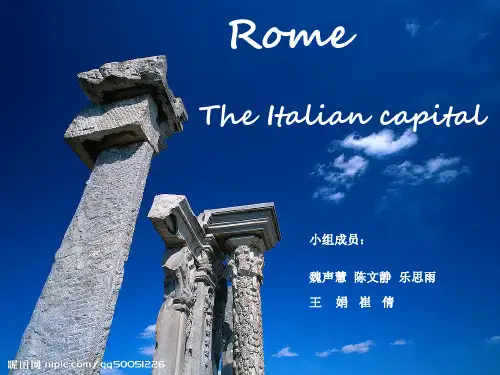
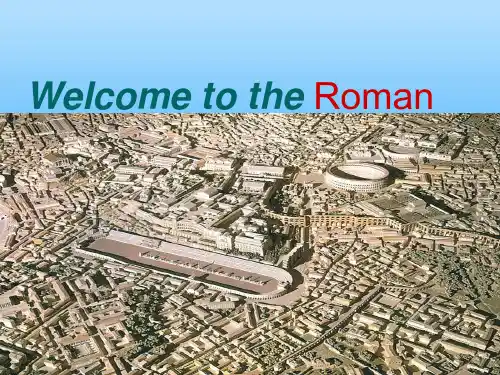
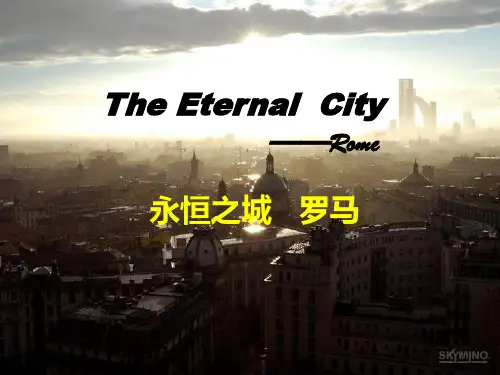
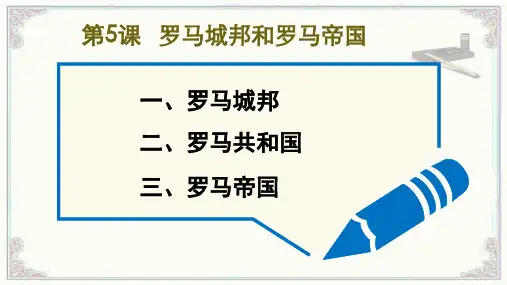
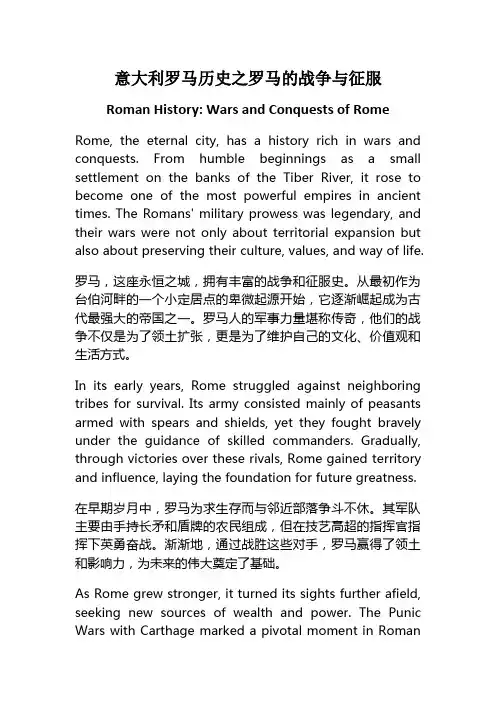
意大利罗马历史之罗马的战争与征服Roman History: Wars and Conquests of Rome Rome, the eternal city, has a history rich in wars and conquests. From humble beginnings as a small settlement on the banks of the Tiber River, it rose to become one of the most powerful empires in ancient times. The Romans' military prowess was legendary, and their wars were not only about territorial expansion but also about preserving their culture, values, and way of life. 罗马,这座永恒之城,拥有丰富的战争和征服史。
从最初作为台伯河畔的一个小定居点的卑微起源开始,它逐渐崛起成为古代最强大的帝国之一。
罗马人的军事力量堪称传奇,他们的战争不仅是为了领土扩张,更是为了维护自己的文化、价值观和生活方式。
In its early years, Rome struggled against neighboring tribes for survival. Its army consisted mainly of peasants armed with spears and shields, yet they fought bravely under the guidance of skilled commanders. Gradually, through victories over these rivals, Rome gained territory and influence, laying the foundation for future greatness. 在早期岁月中,罗马为求生存而与邻近部落争斗不休。
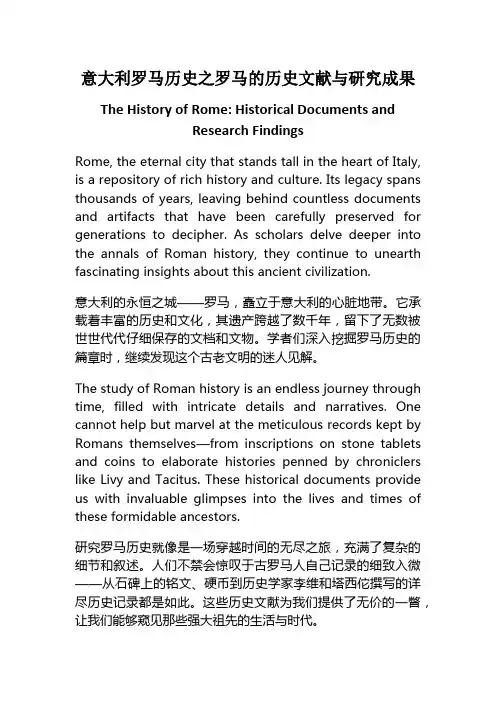
意大利罗马历史之罗马的历史文献与研究成果The History of Rome: Historical Documents andResearch FindingsRome, the eternal city that stands tall in the heart of Italy, is a repository of rich history and culture. Its legacy spans thousands of years, leaving behind countless documents and artifacts that have been carefully preserved for generations to decipher. As scholars delve deeper into the annals of Roman history, they continue to unearth fascinating insights about this ancient civilization.意大利的永恒之城——罗马,矗立于意大利的心脏地带。
它承载着丰富的历史和文化,其遗产跨越了数千年,留下了无数被世世代代仔细保存的文档和文物。
学者们深入挖掘罗马历史的篇章时,继续发现这个古老文明的迷人见解。
The study of Roman history is an endless journey through time, filled with intricate details and narratives. One cannot help but marvel at the meticulous records kept by Romans themselves—from inscriptions on stone tablets and coins to elaborate histories penned by chroniclers like Livy and Tacitus. These historical documents provide us with invaluable glimpses into the lives and times of these formidable ancestors.研究罗马历史就像是一场穿越时间的无尽之旅,充满了复杂的细节和叙述。

罗马帝国的城市遗址罗马帝国,曾经是世界上最伟大的帝国之一,霸权遍及欧洲、北非和中东地区。
在其辉煌时期,罗马帝国拥有许多壮丽的城市,这些城市遗址至今仍在我们周围,为我们展示着古代罗马的辉煌与荣耀。
本文将介绍几个著名的罗马帝国城市遗址。
1. 罗马城(Rome)作为罗马帝国的首都,罗马城是古代罗马最重要的城市之一,如今仍然是意大利的首都。
罗马城的遗址包括了许多重要的建筑和历史遗迹,其中最著名的就是罗马斗兽场(Colosseum)。
这个巨大的露天圆形剧场曾是数千观众观看斗兽表演和其他娱乐活动的场所。
此外,罗马城还有斗兽场、卡拉卡拉浴场、庞贝乡村别墅等等。
2. 庞贝古城(Pompeii)庞贝古城是意大利南部庞贝附近的一座古城,由于公元79年的维苏威火山爆发而埋没在熔岩和火山灰下,几乎完整地保存了下来。
现在,庞贝古城成为一座重要的考古遗址,吸引了全世界的游客。
在庞贝古城中,我们可以看到罗马时代的建筑、街道、壁画等等,这些都是当时罗马社会生活的缩影。
庞贝的发现对我们了解古罗马文化和生活方式有着重要的意义。
3. 埃菲索斯古城(Ephesus)埃菲索斯古城是位于现在的土耳其境内,曾是罗马帝国亚细亚省的一个重要城市。
这个城市在罗马时期达到了巅峰状态,是西亚最大的经济、政治和文化中心之一。
埃菲索斯古城留下了许多令人叹为观止的遗迹,如库斯图姆广场、图列夫图神庙、图西库勒修道院等等。
这些建筑展示了古代罗马的建筑风格和技术,让我们可以想象出当时的繁荣景象。
4. 卡帕多西亚地下城(Cappadocia Underground Cities)卡帕多西亚地下城是罗马帝国时期位于现在的土耳其中部卡帕多西亚地区的地下建筑群。
这些地下城是由当地人为了躲避入侵和迫害而挖掘出来的,提供了隐蔽、保护和居住的地方。
卡帕多西亚地下城的结构复杂而精确,有着多层楼、通道、教堂和储藏室等设施。
这些地下城至今仍然可以参观,让人们感受到当时居民的生活环境和恢宏的工程技术。
![[指导]罗马全面战争城市名](https://uimg.taocdn.com/52ac78fb0875f46527d3240c844769eae009a300.webp)
罗马全面战争城市名{Rome} 罗马{Caledonia} 苏格兰{Dalriada} 爱丁堡{Corsica} 科西嘉岛{Britannia_Inferior} 下不列颠{Tribus_Saxones} 撒克逊{Locus_Gepidae} 格皮德{Hyperboria} 北国{Tribus_Sakae} 塞克{Hibernia} 爱尔兰{Tribus_Alanni} 阿兰尼{Tribus_Silurii} 西卢里{Locus_Gothi} 哥特{Tribus_Sarmatae} 萨尔马提亚{Britannia_Superior} 上不列颠{Germania_Inferior} 下日耳曼{Tribus_Chattii} 卡狄{Pripet} 普利佩特{Regnum_Marcomannii} 马科曼尼{Belgica} 比利时{Maeotis} 梅欧提斯{Agri_Decumates} 阿格里狄古马特{Armorica} 阿莫里卡{Germania_Superior} 上日耳曼{Boihaemum} 波海姆{Scythia} 西徐亚{Tribus_Iazyges} 雅斯基{Central_Gaul} 大高卢{Dacia} 达西亚{Noricum} 诺里库姆{Tribus_Getae} 加泰{Pannonia} 潘诺尼亚{Bosphorus} 博斯普鲁斯{Aquitania} 阿奎塔尼{Lugdinensis} 卢格杜南西斯{Colchis} 科尔基斯{Atropatene} 阿特洛帕特内{Cisalpine_Gaul} 山内高卢{Venetia} 威尼托{Transalpine_Gaul} 山外高卢{Illyria} 伊利里亚{Thrace} 色雷斯{Gallaecia} 加利西亚{Dalmatia} 达尔马提亚{Armenia} 亚美尼亚{Narbonensis} 纳尔榜高卢{Liguria} 雷古利亚{Pontus} 本都{Celtiberia} 坎特伯雷{Paionia} 派奥尼亚{Etruria} 伊特鲁利亚{Taraconenis} 塔拉戈南尼斯{Umbria} 乌布里亚{Media} 米底亚{Lusitania} 卢西塔尼亚{Sardinia} 撒丁岛{Latium} 拉丁{Macedonia} 马其顿{Propontis} 普罗庞提斯{Bithynia} 比提尼亚{Galatia} 加拉太{Cappadocia} 卡帕多西亚{Hispania} 伊比利亚{Epirus} 伊庇鲁斯{Apulia} 阿普里亚{Campania} 坎帕尼亚{Assyria} 亚述{Baetica} 贝提卡{Phrygia} 弗里吉亚{Cilicia} 西里西亚{Thessalia} 色萨利{Baliares} 巴利阿里群岛{Bruttium} 布鲁提恩{Ionia} 爱奥尼亚{Syria} 叙利亚{Babylonia} 巴比伦{Aetolia} 埃托里亚{Attica} 阿提卡{Elymais} 以莱美斯{Peloponnesus} 伯罗奔尼撒{Lycia} 吕西亚{Sicilia_Romanus} 上西西里亚{Sicilia_Poeni} 下西西里亚{Mauretania} 毛里塔尼亚{Regnum_Palmyrae} 帕米拉{Cyprus} 塞浦路斯岛{Phoenicia} 腓尼基{Numidia} 努米底亚{Africa} 阿非利加{Sicilia_Graecus} 大西西里{Laconia} 拉科尼亚{Coele_Syria} 科罗叙利亚{Rhodos} 罗德斯岛{Arabia} 阿拉伯{Byzacium} 拜萨西恩{Crete} 克里特岛{Nabataea} 纳巴泰{Judaea} 犹太{Gaetulia} 加图里亚{Tripolitania} 的黎波里塔尼亚{Cyrenaica} 昔兰尼加{Nile_Delta} 尼罗河三角洲{Sinai} 西奈山{Libya} 利比亚{Middle_Egypt} 中埃及{Sahara} 撒哈拉{Thebais} 底比斯{Eburacum} 约克郡{Bordesholm} 博登肖姆{Domus_Dulcis_Domus} 杜尔西斯{Themiskyra} 塞米斯卡拉{Campus_Sakae} 塞克{Tara} 塔拉{Campus_Alanni} 阿兰尼{Deva} 迪瓦{Vicus_Gothi} 哥特{Campus_Sarmatae} 萨尔马提亚{Londinium} 伦敦{Batavodurum} 巴达维{Damme} 达姆{Vicus_Venedae} 威尼达{Vicus_Marcomannii} 马科曼尼{Samarobriva} 萨马罗布里瓦{Tanais} 塔奈斯{Mogontiacum} 美因茨{Condate_Redonum} 雷恩{Trier} 特里尔{Lovosice} 洛沃西采{Campus_Scythii} 西徐亚{Campus_Iazyges} 雅斯基{Alesia} 阿莱西亚{Porrolissum} 波罗里森{Iuvavum} 萨尔茨堡{Campus_Getae} 加泰{Aquincum} 布达佩斯{Chersonesos} 切索尼斯{Lemonum} 里蒙{Lugdunum} 里昂{Kotais} 库塔伊西{Phraaspa} 弗拉斯帕{Mediolanium} 米兰{Patavium} 帕多瓦{Massilia} 马赛{Segestica} 塞吉斯提卡{Tylis} 泰里斯{Asturica} 阿斯图里加{Salona} 萨罗纳{Artaxarta} 阿尔塔沙特{Narbo_Martius} 纳尔榜玛提厄斯{Segesta} 塞吉斯塔{Sinope} 锡诺普{Numantia} 努曼提亚{Bylazora} 贝拉索拉{Arretium} 亚雷提恩{Osca} 奥斯卡{Ariminum} 亚里米伦{Arsakia} 阿萨基亚{Scallabis} 斯卡拉比斯{Caralis} 卡拉里斯{Roma} 罗马{Thessalonica} 塞萨洛尼卡{Byzantium} 拜占庭{Nicomedia} 尼科米底亚{Ancyra} 安卡拉{Mazaka} 马萨卡{Carthago_Nova} 新迦太基{Apollonia} 阿波罗尼亚{Tarentum} 塔伦图姆{Capua} 卡普亚{Hatra} 哈特拉{Corduba} 科尔多巴{Pergamum} 珀加蒙{Tarsus} 塔尔苏斯{Larissa} 拉里萨{Palma} 帕尔马{Croton} 克罗顿{Sardis} 萨狄斯{Antioch} 安条克{Seleucia} 塞琉西亚{Thermon} 色蒙{Athens} 雅典{Susa} 苏撒{Corinth} 科林斯{Halicarnasus} 哈利卡纳苏斯{Messana} 墨西拿{Lilybaeum} 利利俾{Tingi} 丹吉尔{Palmyra} 帕米拉{Salamis} 萨拉米斯{Sidon} 西顿{Cirta} 瑟塔{Carthage} 迦太基{Syracuse} 叙拉古{Sparta} 斯巴达{Damascus} 大马士革{Rhodes} 罗德斯{Dumatha} 杜马萨{Thapsus} 塔普苏斯{Kydonia} 科多尼亚{Bostra} 波斯卓{Jerusalem} 耶路撒冷{Dimmidi} 狄米迪{Lepcis_Magna} 大列普提斯{Cyrene} 昔兰尼{Alexandria} 亚历山大{Petra} 佩特拉{Siwa} 锡瓦{Memphis} 孟斐斯{Nepte} 涅普特{Thebes} 底比斯。
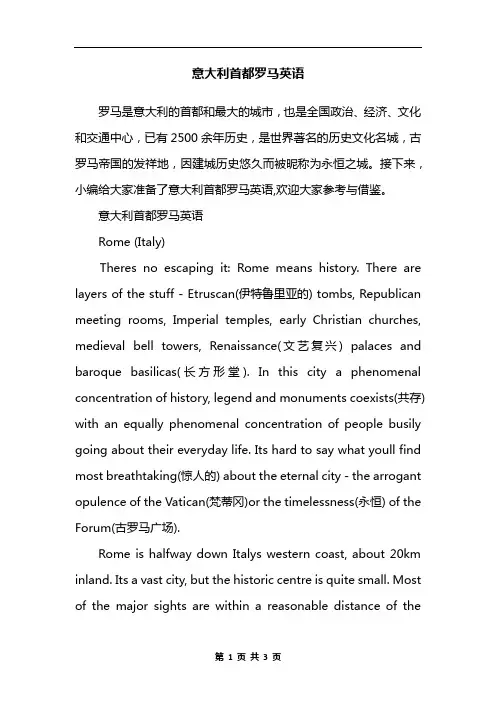
意大利首都罗马英语罗马是意大利的首都和最大的城市,也是全国政治、经济、文化和交通中心,已有2500余年历史,是世界著名的历史文化名城,古罗马帝国的发祥地,因建城历史悠久而被昵称为永恒之城。
接下来,小编给大家准备了意大利首都罗马英语,欢迎大家参考与借鉴。
意大利首都罗马英语Rome (Italy)Theres no escaping it: Rome means history. There are layers of the stuff - Etruscan(伊特鲁里亚的) tombs, Republican meeting rooms, Imperial temples, early Christian churches, medieval bell towers, Renaissance(文艺复兴) palaces and baroque basilicas(长方形堂). In this city a phenomenal concentration of history, legend and monuments coexists(共存) with an equally phenomenal concentration of people busily going about their everyday life. Its hard to say what youll find most breathtaking(惊人的) about the eternal city - the arrogant opulence of the Vatican(梵蒂冈)or the timelessness(永恒) of the Forum(古罗马广场).Rome is halfway down Italys western coast, about 20km inland. Its a vast city, but the historic centre is quite small. Most of the major sights are within a reasonable distance of thecentral railway station. It is, for instance, possible to walk from the Colosseum(罗马圆形大剧场), through the Forum, up to Piazza di Spagna(西班牙广场) and across to the Vatican in one day, but you wouldnt really want to. All the major monuments are west of the train station, but make sure you use a map. While it can be enjoyable to get off the beaten track(平坦的路) in Rome, it can also be very frustrating and time-consuming.Most of the budget(便宜的) places to stay are clustered around Stazione Termini; this area is rife with pickpockets(扒手) and gangs of thieving children, so beware - do your best to look like you know where youre going. It is only slightly more expensive and definitely more enjoyable to stay closer to the city centre.Romes mild climate makes it visitable year-round; however, spring and autumn are without doubt the best times to visit, with generally sunny skies and mild temperatures. Unfortunately, these times are also the peak tourist season, when the tour buses pour in(川流不息的涌入) and tourists are herded around like cattle. July and August are unpleasantly hot, and Romans traditionally desert the stiflingly hot city in August, with many businesses closing; try to avoid visiting at this time. From December to February there is briskly coldweather, although its rarely grey and gloomy.Events-wise, Italys calendar bursts year-round with cultural events ranging from colourful traditional celebrations with a religious and traditional flavour, through to cultural events. Summer is definitely the best time to visit if you want to catch the best of the festivals; however, the Romaeuropa festival is now a feature of the autumn calendar, the Roma opera season runs from December until June and the classical and contemporary music scene is lively all year round.扩展:全国高校大学名称中英文对照武汉市所属大学:1、武汉大学Wuhan University2、中南财经政法大学Zhongnan University Of Economics。
罗马——迷人的城市作者:林熙蕾来源:《中学生英语·学生综合天地》2010年第05期为了能让广大读者开阔视野,了解世界各国民族多姿多彩的风俗习惯,本栏目将系统地介绍各国独特的异域风情。
从本期起,我们将会为大家介绍世界著名的都市。
本期就让我们一起来感受一下罗马风情。
罗马是一个绚丽多彩、引人入胜的古老——古罗马,中世纪罗马,文艺复兴时期罗马——与新兴的综合体。
Rome is the capital of Italy and the country’s la rgest and most populated(人口最多) central area. Tourism(旅游业) is one of Rome’s chief(主要的) industries(行业). One of the symbols(标志) of Rome is the famous Colosseum(古罗马竞技场), the largest amphitheatre(圆形剧场) ever built in the Roman Empire(罗马帝国).罗马是意大利的首都,也是其全国最大和人口最多的一个中心地区。
旅游业是罗马的主要产业之一。
罗马的标志之一就是著名的古罗马竞技场,那是罗马帝国建造的最大的圆形剧场。
Rome is a major international centre for higher education. According to the City Brands(品牌) Index(指数), Rome is considered to be the world’s second most historical, educati onal and cultural city. It has always been a major worldwide intellectual and educational centre, especially during Ancient(古代的) Rome and the Renaissance(文艺复兴).罗马是一个主要的国际高等教育中心。
关于罗马的谚语英文版Rome, the Eternal City, has long been a symbol of civilization, power, and enduring culture. Throughout its rich history, Rome has given birth to countless legends and proverbs that have resonated across the world, serving as a testament to its influence and wisdom. These proverbs, passed down through generations, offer insights into Roman life, values, and beliefs, providing a unique window into the city's past and present.One such proverb is "All roads lead to Rome," which speaks to the city's historical significance as a center of power and trade. In ancient times, Rome was the capital of the Roman Empire, a vast network of territories that stretched across Europe, Africa, and Asia. The city's strategic location and prosperous economy attracted traders and travelers from all corners of the known world, leading to the belief that every journey, regardless of its origin, ultimately converged in Rome. This proverb is not only a geographical statement but also a metaphor for the city's cultural and political influence, which has been felt far and wide throughout history.Another famous Roman proverb is "Rome wasn't built in a day." This saying emphasizes the importance of patience, perseverance, and long-term commitment. Rome's growth and grandeur were not achieved overnight but were the result of centuries of hard work, innovation, and dedication. This proverb serves as a reminder that success and achievement require time, effort, and a sustained commitment to one's goals. It encourages individuals to be patient and to view challenges as opportunities for growth and learning."When in Rome, do as the Romans do" is another well-known proverb that emphasizes the importance of cultural adaptability and respect. This saying encourages visitors to embrace the customs and traditions of the place they are visiting, showing respect for the local culture and people. In the context of Rome, it提醒着游客们要尊重并融入这座城市的独特氛围和历史传统,无论是参观古迹、品尝美食还是参与节日庆典,都应遵循当地的习俗和礼仪。
Rome:The Eternal City I永恒之城:罗马(一)作者:Lily来源:《疯狂英语·初中版》2020年第03期羅马拥有2,800多年的建城历史,为意大利文艺复兴中心,现今仍保存有相当丰富的文艺复兴与巴洛克风貌古迹,被称为“永恒之城”。
Rome is the capital city and special1)commune of Italy.Rome also serves asthe capital of the Lazio region.With morethan 2 million 2)residents in 1,285 km2 ,it is also the country's most populated commune .It is the third most populouscity in the European Union by population within city limits.Rome is located in thecentral-western portion of the ItalianPeninsula, within Lazio, along the shores of the Tiber.1) commune ['kDmju:n】n.行政区;公社2) resident ['rezidant]n.居民Rome's history spans 28 centuries. While Roman 3)mythology dates the founding ofRome at around 753 BC, the site has been 4)inhabited for much longer, making it one ofthe oldest continuously 5)occupied cities in EUrope.The city's early population originatedfrom a mix of Latins, Etruscans, and Sabines. Eventually, the city successively becamethe capital of the Roman Kingdom, the Roman Republic and the Roman Empire, and isregarded by many as the first ever Imperial City and metropolis. It was first called TheEternal City by the Roman poet Tibullus in the 1st century BC, and the expression wasalso taken up by Ovid, Virgil, and Livy*. Rome is alsocalled"Caput Mundi". After the fall ofWestern Roman Empire, which marked the be ginning of the Middle Ages, Rome slowly fellunder the political control of the Papacy, and in the 8th century it became the capital of thePapal States, which lasted until 1870. Beginning with the Renaissance,almost all popessince Nicholas V 1447-1455 pursued a 6)coharent architectural and urban programme overfour hundred years, aimed at making the city the artistic and cultural centre of the world.In this way, Rome became first one of the major centres of the Italian Renaissance, andthen the birthplace of both the Baroque styleand Neoclassicism. Famous artists, painters,7)sculptors and architects made Rome the centreof their activity, creating 8)masterpieces throughoutthe city. In 1871, Rome became the capital of the3) mythology [mi'oolad3i]n.神话4) inhabit[in'haebit]v.栖息,居住5) occupy ['Dkjupai]v.占用6) coherent [kao'hiarant] adj.连贯的,一致的7) sculptor ['skAlpta(r)]n.雕刻家8) masterpiece ['ma:stapi:s]n.杰作Kingdom of Italy, which, in 1946, became the ItaIian Republic.As of 2020 Jan.1, Rome is ranked as an Alpha global city by the Globalization andWorld Cities Research Network. In 2019, Rome was the 11th most visited city in the world,third most visited in the European Union, and the most popular tourist destination in ItaIy.Its historic centre is listed by UNESCO as a World Heritage Site. Host city for the 1960Summer Olympics, Rome is also the seat of several specialized 9)agencies of the UnitedNations, such as the Food and Agriculture Organization, the World Food Programme andthe International Fund for Agricultural Development. The city also hosts the Secretariat ofthe Parliamentary Assembly of the Union for the Mediterranean as well as the headquartersof many international business companies such as Eni, Enel, TIM,and national andinternational banks such as Unicredit and BNL. Rome's EUR business district is the homeof many companies involved in the oil industry, the 10)pharmaceutical industry, and financialservices. The presence of renowned international brands in the city have made Rome animportant centre of fashion and design, and the Cinecitta Studios have been the set ofmany Academy Award-winning movies.9) agency ['eid3ansi]n.代理处,代理10)pharmaceutical [,fa:ma'su:tikl] adj.制药(学)的罗马是意大利的首都,是一个特别行政区,也是拉齐奥大区的首府。
罗马史诗的名词解释在西方文化中,罗马史诗被广泛认为是古代文学的丰碑之一。
它揭示了古代罗马帝国的辉煌和荣耀,以及罗马文化的独特之处。
在这篇文章中,我们将解释一些与罗马史诗相关的重要名词。
1. 史诗(epic)史诗是一种叙事诗,通常涉及英雄事迹或一段历史故事的广阔片段。
它通过丰富的细节和形象来描绘出重要事件,以及与之相关的英雄人物。
罗马史诗通常是长篇的,以载歌载舞的语言来讲述传奇故事。
2. 奥维德(Ovid)奥维德是古罗马最重要的史诗作家之一。
他的作品《变形记》是一部以古希腊罗马神话为基础的史诗,其中包含了丰富的神话故事。
奥维德以其流畅的叙述和多样的主题而闻名,他的写作风格影响了后来的许多作家。
3. 维吉尔(Virgil)维吉尔是另一位罗马史诗的重要代表。
他的作品《埃涅阿斯纪》被公认为是古典史诗的巅峰之作。
这部史诗以传说中的英雄埃涅阿斯为主角,讲述了他逃离特洛伊沦陷后的冒险之旅。
维吉尔通过描绘英雄的勇气和坚韧不拔的精神,强调罗马人的崇高品质。
4. 古罗马(Ancient Rome)古罗马是罗马帝国的前身,几乎延续了千年之久。
它是古代世界的重要文明中心,不仅以其政治和军事实力而闻名,还为后来的文化和社会制度做出了巨大贡献。
罗马历史、宗教和文学的各个方面,都深受罗马史诗的影响。
5. 特洛伊战争(Trojan War)特洛伊战争是古希腊神话中一段著名的故事,也是许多古代文学作品的灵感源泉之一。
传说中,特洛伊战争是由希腊和特洛伊之间的争端引发的。
维吉尔的《埃涅阿斯纪》中详细描绘了特洛伊战争及其后续事件。
6. 反独立史诗(Anti-epic)反独立史诗是一种史诗形式,通过对英雄和神话的讽刺和扭曲,挑战了古代史诗的传统。
奥维德的《变形记》被认为是一部重要的反独立史诗。
这部作品通过变形和转化的神话故事,以不同寻常的视角和幽默的笔调,对传统的英雄叙事进行了戏剧性改写。
7. 纪实诗(Didactic poetry)纪实诗是一种目的在于传授知识和道德教育的诗歌形式。
朱自清《罗马》原文及赏析(最新版)编制人:__________________审核人:__________________审批人:__________________编制单位:__________________编制时间:____年____月____日序言下载提示:该文档是本店铺精心编制而成的,希望大家下载后,能够帮助大家解决实际问题。
文档下载后可定制修改,请根据实际需要进行调整和使用,谢谢!并且,本店铺为大家提供各种类型的经典范文,如诗歌散文、原文赏析、读书笔记、经典名著、古典文学、网络文学、经典语录、童话故事、心得体会、其他范文等等,想了解不同范文格式和写法,敬请关注!Download tips: This document is carefully compiled by this editor.I hope that after you download it, it can help you solve practical problems. The document can be customized and modified after downloading, please adjust and use it according to actual needs, thank you!In addition, this shop provides you with various types of classic sample essays, such as poetry and prose, original text appreciation, reading notes, classic works, classical literature, online literature, classic quotations, fairy tales, experience, other sample essays, etc. if you want to know the difference Please pay attention to the format and writing of the sample essay!朱自清《罗马》原文及赏析【导语】:罗马是朱自清写的一片散文,来了解一下原文及赏析吧。